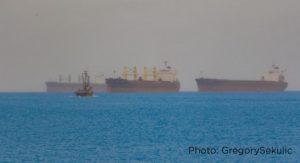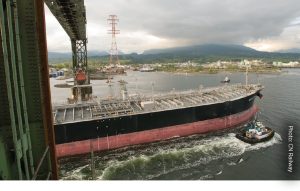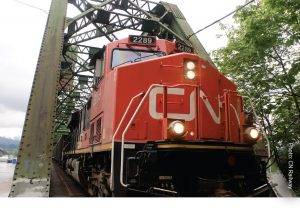Story About A Bridge
One single-track lift bridge, hoisted any time a sailboat pleasure-craft comes along, is all that connects the Cargill, Richardson and brand new G3 grain terminals on the north shore of Vancouver Harbour to all the oilseeds, cereals and pulses grown in Western Canada.
This bridge, the rather nondescript Second Narrows Bridge, almost hidden under the shadow of Highway No.1’s massive and majestically-named Iron Workers Memorial Bridge, is an infamous touchstone for any discussion of Canadian rail infrastructure shortcomings. A bottleneck among bottlenecks.

Of course trade still gets done, and lots of it. Canola stakeholders, including the author of this article, got to see the action first hand in March. As an add-on to the Canadian Crops Convention in Vancouver, the Port of Vancouver provided conference attendees with a boat tour of the harbour. The tour included a spin beyond the Lions Gate Bridge, the iconic suspension bridge officially known as First Narrows Bridge, to see all the freighters parked and waiting in their assigned mooring spots. Gregory Sekulic, Canola Council of Canada agronomy specialist, was on the tour and says the flotilla reminded him of the Battle of Jutland.

Between the two Narrows Bridges are north and south shores chock-a-block with ship loading and unloading facilities for pretty much everything you can imagine. On the north shore, the focus of this article, are the three major grain terminals mentioned in paragraph one as well as Neptune Bulk Terminals for coal and potash, Fibreco for wood products and many others. These many millions of tonnes of bulk commodities ready for export on the north shore come in by rail over the Second Narrows Bridge. That is why the one-track lift bridge gets so much attention.
But this is where the story gets tricky. The story about a bridge is about so much more than just a bridge. The green-painted 1960s era Second Narrows Bridge is just one piece of an ambitious infrastructure project to expand rail capacity and turnaround time for the busy (and getting busier) sprawling Port of Vancouver complex.
“If we give you the best bridge in the world, it won’t solve the problem.”
Doug Mills, senior account representative with the Port of Vancouver, says expanding the bridge’s capacity won’t help much unless a bunch of other things are expanded at the same time. “If we give you the best bridge in the world, it won’t solve the problem,” he says.
It makes one think of Justus von Liebig’s Law of the Minimum, which refers to crops but fits here, too: growth is dictated by availability of the most limiting resource. It doesn’t make any sense to apply more nitrogen if what the crop really needs is water or heat or sulphur or whatever. The way Mills describes the situation, the Second Narrows Bridge is just one stave in a barrel of bottlenecks. Fixing the bridge without addressing the other limiting resources is like putting a four-lane bridge on a gravel country road.
That is why the Vancouver Fraser Port Authority, which is the organization responsible for maintaining the Port of Vancouver on behalf of the federal government, has a $17 billion master plan called Gateway 2030 that includes, as just one of many components, the Burnaby Rail Corridor Improvements Project to address these bottlenecks. This five-kilometre corridor has three major pinch points – a level crossing at Douglas Road, the Thornton Tunnel and Second Narrows Bridge.

Burlington Northern owns the section of track at Douglas Road and CN owns the tunnel and the bridge. CP has access to the north shore terminals through Canadian Transportation Agency inter-switching. (There’s a lot of sharing of track in B.C.’s lower mainland, a rail network that services seven railways: CN, CP, Burlington Northern, a short-rail called Southern Railway of B.C. and passenger trains Via, Amtrak and Rocky Mountaineer.) Fixing the corridor is further complicated by the challenging landscape – including water, hills, and a big, busy metropolitan area – and various governments often pressured by their electorate to put local concerns ahead of national interests.
“Vancouver is not a simple terminal,” says Mark Hemmes, president of Quorum Corporation, the government-appointed monitor of Western Canada’s grain handling system.
Three parts of the Burnaby Rail Corridor Improvements Project

Part 1. Douglas Road level crossing. This is where the north shore corridor bottleneck begins. Trains meet a level crossing at Douglas Road in Burnaby, about five km from the Second Narrows Bridge. Because trains are too long to fit between Douglas Road and the opening of the Thornton Tunnel, the trains have to wait behind the level crossing. Then, once the tunnel is accessible, these 120-car fulled loaded trains start from a standing stop and crawl through the tunnel to the bridge, blocking Douglas Road traffic for many minutes at a time and multiple times a day. Joint funding for a $145 million overpass was announced in January 2020, but the project won’t have a green light until the City of Burnaby completes an environmental assessment. The timeline to complete the overpass is 2024.
Meanwhile, CN also has plans to add a third length of track in this Douglas Road area to hold another train leading into the tunnel and bridge so, when access is available, trains can move to the north shore as quickly as possible.
“If CN can stage trains right up close to the bridge instead of staging them much further back, CN can move them over to the north shore that much more quickly when the bridge is available for transit,” says David Przednowek, CN’s director of sales and marketing.
Part 2. Thornton Tunnel. This 3.2-km single-track tunnel takes trains under most of Burnaby. It was constructed in the 1960s when the Port of Vancouver was rather sleepy compared to today, yet the single track is not the biggest issue with the tunnel. Ventilation is. After one train fills the tunnel with exhaust, the current ventilation system requires 20 minutes to clear the air for the next crew coming through.

Przednowek says ventilation improvements are planned. “These include the addition of several jet fans within the tunnel along with a control system to manage airflow,” he says. The goal is get to the tunnel cleared in five minutes.
As part of its $170 million contribution to Vancouver-area infrastructure, CN will contribute $75 million to these Burnaby corridor projects.
Part 3. Second Narrows Bridge. As with the tunnel, the single track is not the big issue. Once the Douglas Road level crossing and the Thornton Tunnel ventilation issues are resolved, the bridge bottleneck can be brought in line rather simply, by comparison, with a local modification to the laws of the sea.
“International law says that if a bridge crosses navigable water, marine traffic has the right of way,” Hemmes says. This includes the tankers that pick up bulk canola oil from Pacific Coast Terminals and other liquid facilities at Port Moody, and it includes personal sailboats. “The bridge takes 20 to 25 minutes to lift, let the boat pass, and then lower,” Hemmes says.
Mills says the corridor plan includes a request to change these protocols. “Does it still make sense that marine traffic automatically has priority access? It may not be practical any more,” he says. “We’d like to see the Marine Act changed to rationalize that approach.”
“As vessel traffic increases over time, so too will the period of time that the bridge is not available to move rail traffic over.”
The bridge is open and unavailable to train traffic for over six hours per day, Przednowek says, “and as vessel traffic increases over time, so too will the period of time that the bridge is not available to move rail traffic over.”
While CN does receive an advanced vessel line-up each day, with two-hour advance notice of lift request, a set lift schedule for all traffic, including personal water craft, would mean trains can enter the tunnel knowing that they’ll be able to cross the bridge without delay.
“We are actively engaged in discussions with Transport Canada around what potential amendments to the Marine Act would look like,” Mills says.
Where we are now?
The Port of Vancouver has already made a lot of progress to improve rail access to north and south shore terminals around Vancouver Harbour. Mills started in the marine industry 30 years ago. “At that time, the port was seen as an unlimited resource, but then we came into a wave of off-shore trading, particularly with Asia, and it came as a splash of cold water for everybody,” he says. “We really weren’t ready.”
Issues with the port became painfully obvious around 20 years ago when big winds in Vancouver and snow on the rail lines brought freight movement to a halt. “Ramifications were felt across the country. We couldn’t get goods to our customers,” Mills says. “Containers were sitting on the dock for four months.”
“It was a real black eye for the port,” he says. “We couldn’t allow that to happen again.”
So they brought together industry stakeholders, railway experts and academics to map the network, model the bottlenecks and draw up a plan to provide “supply-chain fluidity,” Mills says. These meetings birthed the Asia-Pacific Gateway Corridor Initiative that outlined essential investments – which is the predecessor to the Gateway 2030 plan – with a timeline and sequence for getting them done. For its part, the federal government’s National Trade Corridors Fund has announced a $2 billion contribution.
Port of Vancouver – notable statistics
The Port of Vancouver is Canada’s largest port by a wide margin. Based on tonnage handled, it is the size of Canada’s next five ports combined. Bulk commodities account for about 70 per cent of the tonnage. The rest comes and goes in containers, “break bulk” (stuff that doesn’t flow – like logs and lumber) and automobiles.
Top five bulk commodities handled through the whole port (not just the north shore) in 2019: Coal, 36.9 million tonnes; Grain, 23.5 million tonnes; Chemicals, base metals and minerals, 13.8 million tonnes, Fertilizers, 11.8 million tonnes; Forest products, 5.9 million tonnes.
The new 180,000-tonne G3 grain terminal on the north shore can receive up to three 150-car trains on its loop track. With the loop track, trains quickly unload while in motion and exit without detaching from their locomotives. Its three large ship loaders move grain on board at up to 6,500 tonnes per hour, setting a new industry standard.
As part of the Gateway 2030 plan, the port has already achieved a much-needed separation of street traffic and rail traffic along north and south shores of Vancouver Harbour. These last-mile improvements have made it a lot easier to unload trains and decrease turn-around time right at the terminals, but bulk commodity exporters on the north shore are depending on the improvements outlined in this article.
“Companies spent one billion dollars on north shore exporting capacity and these companies expect that these rail limitations will be fixed,” Hemmes says.
When asked what the Port of Vancouver needs from its stakeholders – like the Canola Council of Canada and Canadian Canola Growers Association – to help move the Gateway projects along, Mills says, “We need them to let their federal representatives know these projects are important to ensure access to critical foreign markets through this gateway.”
“The crop logistics working group has and is looking at supply chain resiliency and this is a major component of it.”
Steve Pratte, policy development manager and transportation specialist with the Canadian Canola Growers Association, says, “We bring it up when and where possible with the railways, in front of government and in formal submissions. The crop logistics working group has and is looking at supply chain resiliency and this is a major component of it.”
This story about a bridge demonstrates the importance of infrastructure investment to Canada’s trade, especially of grain to Asia, and how one seemingly minor bridge can mean so much to Canada’s farm economy.
“The point I’d like to make to farmers,” says Doug Mills, “is that we’re on it.”





